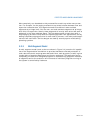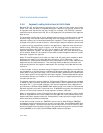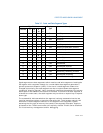
Vol. 3 3-13
PROTECTED-MODE MEMORY MANAGEMENT
3.4.5 Segment Descriptors
A segment descriptor is a data structure in a GDT or LDT that provides the processor
with the size and location of a segment, as well as access control and status informa
-
tion. Segment descriptors are typically created by compilers, linkers, loaders, or the
operating system or executive, but not application programs. Figure 3-8 illustrates
the general descriptor format for all types of segment descriptors.
The flags and fields in a segment descriptor are as follows:
Segment limit field
Specifies the size of the segment. The processor puts together the
two segment limit fields to form a 20-bit value. The processor inter
-
prets the segment limit in one of two ways, depending on the setting
of the G (granularity) flag:
• If the granularity flag is clear, the segment size can range from
1
byte to 1 MByte, in byte increments.
• If the granularity flag is set, the segment size can range from
4
KBytes to 4 GBytes, in 4-KByte increments.
The processor uses the segment limit in two different ways,
depending on whether the segment is an expand-up or an expand-
down segment. See
Section 3.4.5.1, “Code- and Data-Segment
Descriptor Types”, for more information about segment types. For
expand-up segments, the offset in a logical address can range from 0
Figure 3-8. Segment Descriptor
31
24
23
22
2120 19 16
15
13
14 12
11
87
0
P
Base 31:24
G
D
P
L
TypeS
L
4
31
16
15
0
Base Address 15:00
Segment Limit 15:00
0
Base 23:16
D
/
B
A
V
L
Seg.
Limit
19:16
G — Granularity
LIMIT — Segment Limit
P — Segment present
S — Descriptor type (0 = system; 1 = code or data)
TYPE — Segment type
DPL — Descriptor privilege level
AVL — Available for use by system software
BASE — Segment base address
D/B — Default operation size (0 = 16-bit segment; 1 = 32-bit segment)
L — 64-bit code segment (IA-32e mode only)


















